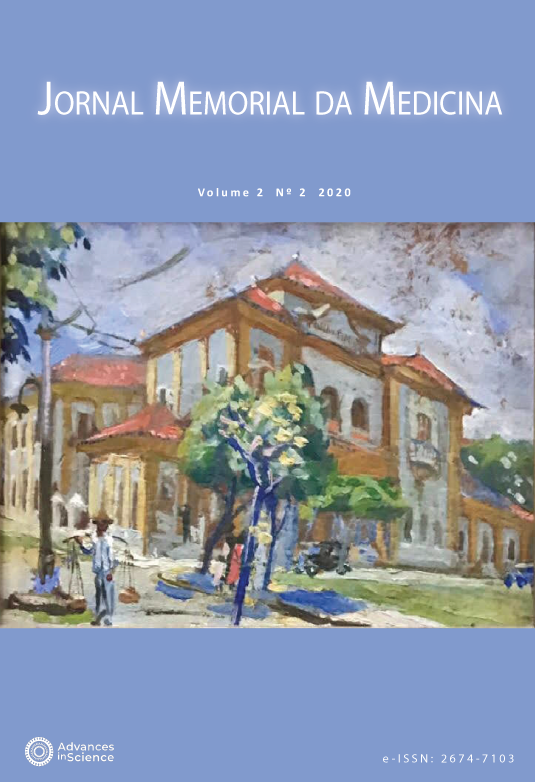Association of T2 signal intensity of magnetic resonance imaging (MRI) of intracranial meningiomas with their consistency – a review
Visualizações: 586DOI:
https://doi.org/10.37085/jmmv2.n2.2020.pp.1-7Palavras-chave:
meningioma, consistency, MRI, predictionResumo
Diferents studies have shown a possible association of neuroimaging as a predictor of intratumoral consistency, an important factor during surgery. To identify the correlation between the consistency of intracranial meningiomas and the image of the T2 sequence of magnetic resonance imaging. Using the PRISMA methodology, a search for clinical studies was carried out in the PubMed, Scielo, Medline and Cochrane databases; descriptors: “consistency”, “meningioma”, “MRI” and “prediction”. Twelve articles were found, with seven remaining after the inclusion criteria: articles written in English and published in the last ten years. The T2-weighted magnetic resonance sequence showed highest degree of correlation in the studies discussed, where T2 hyperintensity of soft tumors may be related to a higher water content, while T2 hypointensity for hard tumors may be due to the greater collagen and calcium content. Most studies allow an association to be established between the soft consistency of the tumor and signal hyperintensity in the T2 sequence of magnetic resonance imaging, with the consistency of the tumor being important, as the surgical difficulty and time depend on it. The hyperintensity of the lesion in T2 was associated with the soft consistency of the tumor, seen during the operation, whereas hypointense meningioma in T2 is associated with firm consistency.
Downloads
Referências
Alyamany M, Alshardan MM, Jamea AA, ElBakry N, Soualmi L, Orz Y (2018) Meningioma Consistency: Correlation Between Magnetic Resonance Imaging Characteristics, Operative Findings, and Histopathological Features. Asian J Neurosurg, 13(2):324-328.
Yao A, Pain M, Balchandani P, Shrivastava RK (2018) Can MRI predict meningioma consistency?: a correlation with tumor pathology and systematic review. Neurosurg Rev, 41(3):745-753.
Smith KA, Leever JD, Hylton PD, Camarata PJ, Chamoun RB (2017) Meningioma consistency prediction utilizing tumor to cerebellar peduncle intensity on T2-weighted magnetic resonance imaging sequences: TCTI ratio. J Neurosurg, 126(1):242-248.
Shiroishi MS, Cen SY, Tamrazi B, D'Amore F, Lerner A, King KS, et al. (2016) Predicting Meningioma Consistency on Preoperative Neuroimaging Studies. Neurosurg Clin N Am, 27(2):145-154.
Watanabe K, Kakeda S, Yamamoto J, Ide S, Ohnari N, Nishizawa S, et al (2016) Prediction of hard meningiomas: quantitative evaluate on based on the magnetic resonance signal intensity. Acta Radiol, 57(3):333-340.
Romani R, Tang WJ, Mao Y, Wang DJ, Tang HL, Zhu FP, et al. (2014) Diffusion tensor magnetic resonance imaging for predicting the consistency of intracranial meningiomas. Acta Neurochir (Wien), 156(10):1837-1845.
Sitthinamsuwan B, Khampalikit I, Nunta-aree S, Srirabheebhat P, Witthiwej T, Nitising A (2012) Predictors of meningioma consistency: A study in 243 consecutive cases. Acta Neurochir (Wien), 154(8):1383-1389.
Hoover JM, Morris JM, Meyer FB (2011) Use of preoperative magnetic resonance imaging T1 and T2 sequences to determine intraoperative meningioma consistency. Surg Neurol Int, 2:142.
Karthigeyan M, Dhandapani S, Salunke P, Singh P, Radotra BD, Gupta SK (2019) The Predictive Value of Conventional Magnetic Resonance Imaging Sequences on Operative Findings and Histopathology of Intracranial Meningiomas: A Prospective Study. Neurol India, 67(6):1439-1445.
Downloads
- PDF (English) 804
Publicado
Como Citar
Edição
Seção
Licença
Os direitos autorais para artigos publicados no Jornal Memorial da Medicina são do autor, com direitos de primeira publicação para a revista. Em virtude de aparecerem nesta revista de acesso público, os artigos são de uso gratuito, com atribuições próprias, em aplicações educacionais e não comerciais. O Jornal Memorial da Medcina permitirá o uso dos trabalhos publicados para fins não comerciais, incluindo direito de enviar o trabalho para bases de dados de acesso público. Os artigos publicados são de total e exclusiva responsabilidade dos autores. Há encargos para submissão no processamento de artigos (Articles Processing Charge - APC).







